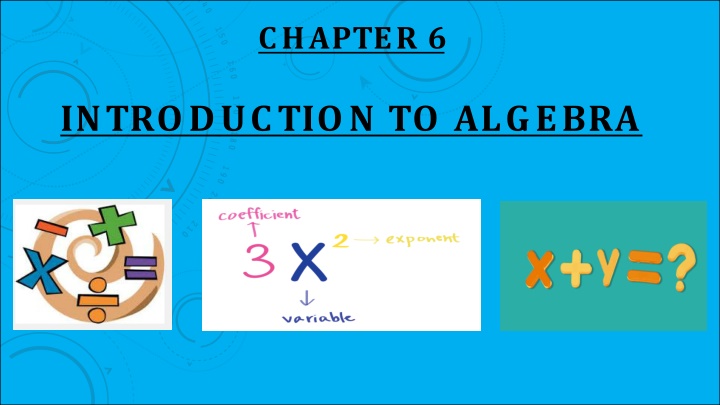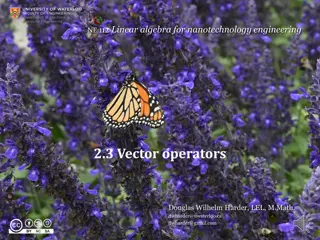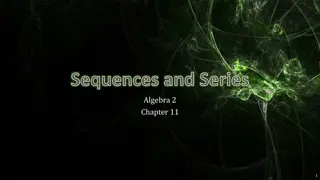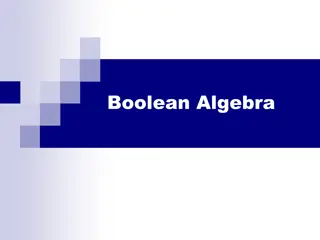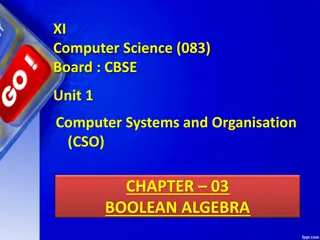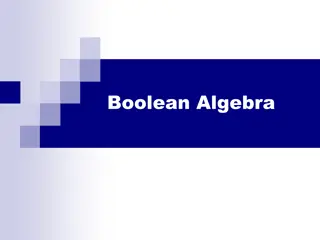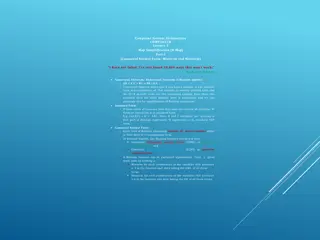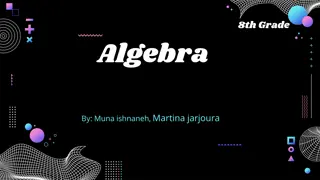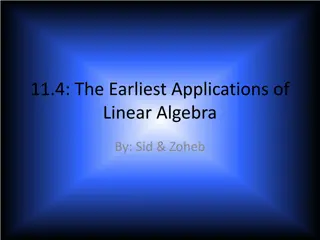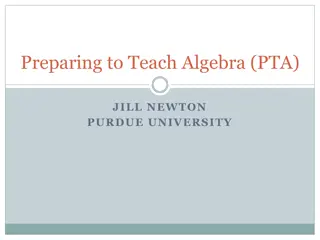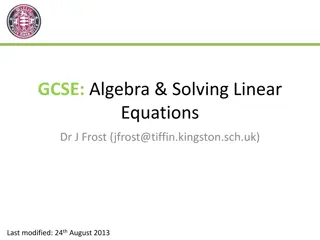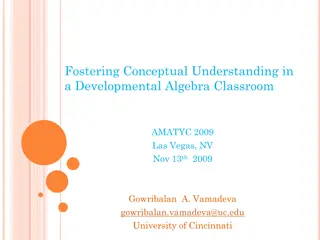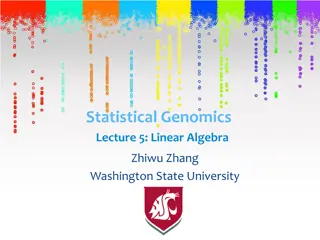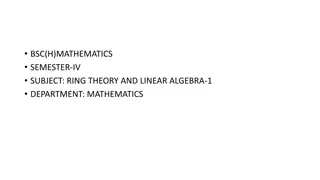Introduction to Algebra: Understanding the Basics and History
Algebra, a fundamental branch of mathematics, uses letters and symbols to represent numbers and quantities in equations. This chapter covers the history of algebra, from its origins in ancient Egypt to its development by mathematicians like Al-Khwarizmi and Viète. Students will learn to work with algebraic expressions, identify terms, understand variables and constants, and perform operations like addition and subtraction. Through activities and examples, they will gain a solid foundation in the language of algebra.
Download Presentation

Please find below an Image/Link to download the presentation.
The content on the website is provided AS IS for your information and personal use only. It may not be sold, licensed, or shared on other websites without obtaining consent from the author.If you encounter any issues during the download, it is possible that the publisher has removed the file from their server.
You are allowed to download the files provided on this website for personal or commercial use, subject to the condition that they are used lawfully. All files are the property of their respective owners.
The content on the website is provided AS IS for your information and personal use only. It may not be sold, licensed, or shared on other websites without obtaining consent from the author.
E N D
Presentation Transcript
CHAPTER 6 INTRODUCTION TO ALGEBRA
CONTENT Objectives A Brief History about Algebra Introduction Algebraic Expressions Activity 1 Terms - Like and Unlike Terms Variables and Constants Coefficients Rules of Operations of Algebraic Expressions Addition of Algebraic Expressions Subtraction of Algebraic Expressions Evaluation of Algebraic Expressions Activity 2 Summary
OBJECTIVES To enable students to: Understand the language of algebra (use of letters of the alphabets to represent numbers). Understand Variables. Differentiate between Variables & Constants. Form an algebraic expression. Identify the like and unlike terms.
OBJECTIVES To enable students to: Know the number of terms in an algebraic expressions. Substitute numbers for letters of the alphabet in expressions and formula. Find out the addition of algebraic expressions by horizontal and column method. Find out the subtraction of algebraic expressions by horizontal and column method. Evaluate the algebraic expressions by substituting the given value.
A BRIEF HISTORY ABOUT ALGEBRA Algebra began its journey as a branch of Mathematics around 1550 BC (around 5500 years ago) with people in Egypt using symbols to denote unknown numbers. The word algebra is derived from the title of the book Algebar W al-almugatalah written about 825AD by an Arab mathematician Mohammed Ibn Musa Al Khwarizmi of Baghdad. Indian mathematician Aryabhatta is said to have introduced Algebra in India. The first person to develop algebraic method of problem solving was the French mathematician Francois Viete. He is also called the Father of Algebra .
WHAT IS ALGEBRA? The part of the mathematics in which letters and other general symbols are used to represent numbers and quantities in formulae and equations.
6 + = 10 = 4 Can you solve? 2 + x = 10 x = 8 So letters in Maths are just missing numbers. When letters of alphabet represent numbers, they are called Literal Numbers.
Try this yourself! Use algebra to write: x 2 d + 4 a + 6 y + g q - z 5 - m 1) 2 less than x 2) 4 more than d 3) 6 together with a 4) y more than g 5) z less than q 6) m less than 5
WHAT IS ALGEBRAIC EXPRESSION? A combination of numbers, literal numbers and the fundamental operations is called an Algebraic Expression. Example: 5x + 3y 4 5x, 3y and 4 are the parts separated by the symbols (+) and (-) signs.
ACTIVITY - 1 How many sweets are in this bag? n n
We dont know! n n We have to call it n for any number!
How many sweets are here?? n n n n n n 3 bags of n and 2 more! We write this as 3n + 2
Now, write the expression for the number of sweets in the picture given below. n n n n n n n n n n n n Ans 6n + 5
Term 3? 2? + 7 What is a Term? Parts of an algebraic expression separated by the symbols (+) and (-) are called the Terms of an algebraic expression.
TERMS LIKE TERMS UNLIKE TERMS Terms having the same variables. Terms having different variables. Examples Examples 4x, 7x , -2x 7x , -5y , 5x2 They have the same variable x and therefore are like terms. They have different variables (such as x,y,x2) and therefore are unlike terms.
Variables 3? 2? + 7 What is a Variable? A variable is a symbol which represents a quantity that can change.
Constant 3? 2? + 7 What is a Constant? A quantity which does not change its value is called Constant.
Coefficients 3? 2? + 7 What is a Coefficient? The number that is multiplied by the variable is called Coefficient.
For the expression: 7x + 3y 9 Name: 1. a term 2. the constant 3. a coefficient 4. a variable
For the expression: 7x + 3y 9 Name: 1. a term 7x or 3y or -9 2. the constant -9 3. a coefficient 7 or 3 4. a variable x or y
NAMES OF ALGEBRAIC EXPRESSIONS
OPERATIONS ON ALGEBRAIC EXPRESSIONS Two or more terms can only be added or subtracted if they are like terms. Unlike terms cannot be added or subtracted.
ADDITION OF ALGEBRAIC EXPRESSIONS Jack has some toys, we do not know how many toys he has . so we can say Jack has xtoys If Jack buys 6 more toys, how many toys has he now got? x + 6
ADDITION OF MONOMIALS Like Terms Example: Add 5x, 4x and 3x 5x + 4x + 3x = (5+4+3)x = 12x (Adding numerical coefficient of each monomial)
ADDITION OF MONOMIALS Unlike Terms Example: Add 4x, 2y, -y and 3x 4x + 2y + (-y) + 3x = (4x + 3x) + (2y y) = 7x + y We have unlike terms Regrouping like terms
ADDITION OF BINOMIALS Two ways to solve addition of algebraic expressions:- 1. Horizontal Method: 2. Column Method:
1. HORIZONTAL METHOD In this method, all expressions are written in a horizontal line and then the terms are arranged to collect all the groups of like terms and then added. Example: (3x2 + 5x 3) + (x2 5x + 1) = 3x2 + 5x 3 + x2 5x + 1 (remove the brackets, identify the like terms) = 3x2 + x2 + 5x 5x 3 + 1 (group the like terms together) = 4x2 + 0 - 2 = 4x2 2 (Ans.)
2. COLUMN METHOD In this method each expression is written in a separate row such that there like terms are arranged one below the other in a column. Then the addition of terms is done column wise. Example :-
SUBTRACTION OF ALGEBRAIC EXPRESSIONS Ram catches x fish. Bharat takes 3 away from him. How many fish does Ram now have? x 3
SUBTRACTION OF ALGEBRAIC EXPRESSIONS The steps for subtraction of algebraic expressions are: 1. Arrange the terms of the given expression in the same order. 2. Write the given expressions in such a way that the like terms occur one below the other, keeping the subtracted in the second row. 3. Change the sign of each term in the lower row from + to and to +. 4. With new signs of the terms of lower row, add column wise.
Example of Subtraction (2x2+ 2y2- 6) from (3x2- 7y2+ 9) 1. Horizontal Method 2. Column Method (3x2 7y2 + 9) -(2x2+ 2y2- 6) = 3x2 7y2 + 9 - 2x2 - 2y2 + 6 = (3x2 - 2x2)+ ( 7y2 - 2y2)+ (9 + 6) = x2 9y2 + 15
TRY IT YOURSELF ! 6a 2a2 1) 4a 5a2 + 2a + 3a2 = - 5a b 2) 5a + 2b 10a 3b= - 3x-2y 3) 3y 4x 5y + x = 7x -14x2 4) -4x2 + 7x 10x2 = -13r2 5) r2 + 2r 7r2 7r2 2r =
EVALUATION OF ALGEBRAIC EXPRESSIONS Example: Evaluate means to find What is the value of x + 4 the value of an when x = 2? x = 2 algebraic expression by x + 4 substituting numbers in = 2 + 4 for variables. = 6
If Radha was born in 2002. You can find out what year Radha will turn 18 by adding the year she was born to her age. In this case, if we add 18 to add to 2002, 2002 + 18 = 2020 Similarly, x can be Radha s age. Therefore, Radha turns x year old and the expression is given by, 2002 + x.
Evaluate the expression for the given value of the variable: 4x 3 for x = 2. 4x 3 for x = 2. 4(2) 3 = 8 3 = 5 Substitute for x Multiply Subtract
Try It Yourself! 1. Evaluate x + 4 for each value of x. A. x = 14 B.x = 83. 2. The expression 7d gives the number of days in d weeks. Calculate the number of days in 52 weeks.
1. Evaluate x + 4 for each value of x. A. x = 14 1. Evaluate x + 4 for each value of x. B. x = 83. x = 14 x + 4 = 14 + 4 = 18 x = 83 x + 4 = 83 + 4 = 87
2. The expression 7d gives the number of days in d weeks. Calculate the number of days in 52 weeks? The expression is given by 7d. In this case, d = 52 7d = 7(52) = 364
ACTIVITY - 2 1. Think of a number 2. Multiply it by 2 3. Add 10 to the number 4. Divide total by 2 5. Subtract number you picked from total
The Answer will be 5 !!!! Step 1 Let the number be x. Step 2 If it is multiplied by 2 => 2x Step 3 Add 10 to the number => 2x + 10 Step 4 Divide total by 2 =>2x + 10 Step 5 Subtract number you picked (i.e. x) from total => x + 5 x = 5 = x + 5 2
SUMMARY 1. The letters which are used to represent numbers are called Literal Numbers or Literals. 2. Literal numbers obey all the properties regarding the operation subtraction, multiplication or division. 3. Constant is a quantity which does not change its value. 4. Variable is a quantity which changes its value. of addition,
SUMMARY 5. Algebraic Expression is a combination of numbers, literal numbers and fundamental questions. 6. Parts of an algebraic expression separated by the symbols (+) and (-) are called the terms. 7. Terms having same variables are called Like Terms and terms having different variables are called Unlike Terms. 8. For addition and subtraction expression only like terms are to be added or subtracted in both horizontal and column method. of algebraic
Thank You!
